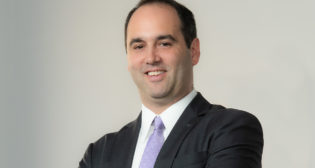
FRA morale tops among rail agencies
Written by Frank N. Wilner, Capitol Hill Contributing Editor
FRA Administrator Ron Batory.
Some in the federal work force may say, “Take this job and shove it,” but not so at the Federal Railroad Administration (FRA), where job satisfaction for 2018 was the highest among the Department of Transportation’s nine modal administrations.
FRA scored better than the Federal Transit Administration (FTA), as well as the other rail-related federal agencies, the Railroad Retirement Board (RRB) and Surface Transportation Board (STB); but trailed the multi-modal National Transportation Safety Board (NTSB).
The “Best Places to Work in the Federal Government” rankings are compiled annually by the nonpartisan Partnership for Public Service and Boston Consulting Group, and based on a survey by the U.S. Office of Personnel Management of some 850,000 civil servants at 488 federal agencies.
At the FRA, 79.3% of employees consider the agency a good place to work, up sharply from years prior to the February 2018 arrival of Administrator Ronald L. Batory. The FRA in 2018 ranked No. 37 among 415 agencies considered “subcomponents” of larger federal agencies (such as the Department of Transportation).
During the final three years (2012-2015) of FRA leadership under former Administrator Joseph C. Szabo, employee morale declined steadily from 76.9% to 67.5%. From 2015-2016, under Acting Administrator Sarah E. Feinberg, FRA employee job satisfaction fell a bit further, with 67.3% of employees expressing job satisfaction.
FRA employee morale climbed more than 10 percentage points to 77.2% following Feinberg’s departure as career bureaucrats led the agency, awaiting Batory’s February 2018 Senate confirmation. With Batory in charge, FRA employee morale rose another 2.1 percentage points to 79.3%, which was among the highest improvement among federal agencies. Employee perceptions of “effective leadership” reached their highest (68.9%) in 2018 since first measured by the survey in 2012.
The disparities under FRA leadership are striking if, for no other reason, that Szabo previously was a labor union officer and Batory previously was President and Chief Operating Officer of Conrail Shared Assets and the Belt Railway of Chicago. While Batory was heading Conrail, then-United Transportation Union President Paul Thompson said, “Railroad presidents like Batory could put labor unions out of business.”
At the STB, results were disappointing, where job satisfaction has tumbled markedly since the 2016 departure of Chairman Daniel R. Elliott, a former labor union attorney.
For the first five years of Elliott’s chairmanship (2009-2014), the STB ranked No. 1 in employee job satisfaction among the then 31 small federal agencies, reaching a high of 91.1% in 2011. While the STB’s job satisfaction ranking slipped to No. 5 in 2015 (79.8%), it tumbled under Elliott’s successor, Ann D. Begeman, hitting a ranking of 18 among 29 small federal agencies in 2017 (66.3%), and a lower ranking of 19 in 2018, with only 64.0% of STB employees expressing job satisfaction.
Employee perceptions of “effective leadership” also fell under Begeman’s chairmanship. Where they were as high as 80.9% under Elliott in 2014, and never lower than 70.8% (2009, his first year), just 60.5% of STB employees considered leadership “effective” in 2018.
Although STB employment has fallen from the mid-130s, during Elliott’s tenure, to 112 in 2018, the workload has been less strenuous, as Begeman has not advanced several rulemakings since becoming chairman 23 months ago. There hasn’t been a major rate case filed since Jan. 15, 2015, and there have been no Class I merger cases to be decided. See, https://www.railwayage.com/regulatory/stb-nothings-the-something-it-does-best/
At the Railroad Retirement Board (RRB), which has not had a chairman since mid-2015, its employee morale ranking declined from 12 among 29 small federal agencies in 2015 to 21 in 2018, with just 63.1% of its employees expressing job satisfaction in 2018. In 2014, the final full-year of Michael Schwartz’ chairmanship, employee morale was more than five percentage points higher, at 68.6%, and the board’s job-satisfaction ranking among 29 small federal agencies was as high as 10, and never lower than the mid-teens under Schwartz’ leadership.
Perhaps owing to understandable policy-position tension between two other RRB members–one representing labor, the other management—employees consistently have ranked the board’s “leadership effectiveness” in the mid-50% range.
At the Federal Transit Administration, 65.6% of employees expressed job satisfaction for 2018, giving the agency a ranking of 206 among 415 “subcomponent” agencies, and far below that of the FRA’s No. 37 ranking. FTA employee morale in 2018 was only slightly better than in 2017 (64.1%), but up substantially from a low of 56.8% in 2015. Employee perception of “effective leadership” climbed from a low of 52.5% in 2015 to 60.1% in 2018.
The improvements have occurred under Acting Chairman K. Jane Williams, a career bureaucrat, formerly a senior officer at the Maryland Department of Transportation and previously in management posts at the Department of Energy and Department of Labor. The FTA hasn’t had a Senate confirmed administrator since Peter Rogoff departed in 2014.
Also, of note, employee job satisfaction at the National Transportation Safety Board (NTSB) ranked 6th among 29 small federal agencies in 2018, with 77.8% of employees expressing high morale; up only slightly from 2017, and significantly higher than the 63.3% in 2013. Employee perceptions of effective leadership at the NTSB also have risen significantly—from 53.0% in 2013 to 65.8% in 2018. Robert L. Sumwalt became chairman in 2017, following 11 years as a board member serving under two previous chairmen—Christopher A. Hart (2015-2017) and Deborah A.P. Hersman (2004-2014).
The National Mediation Board was not included in the survey.
To view more detailed results, use this link:



